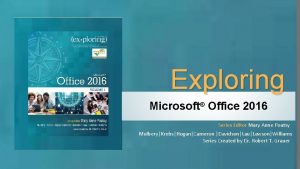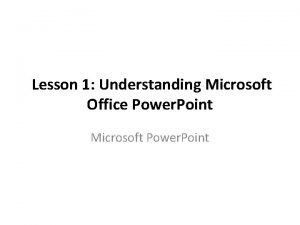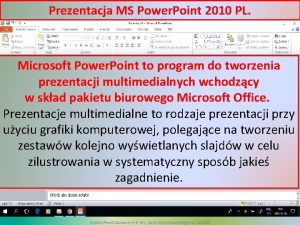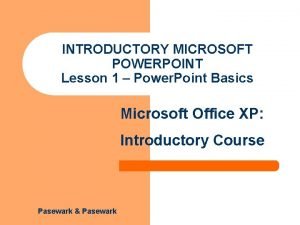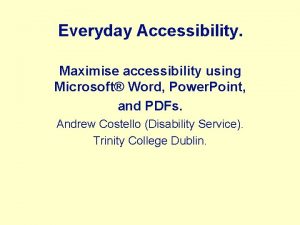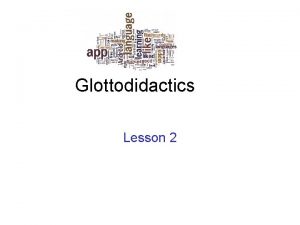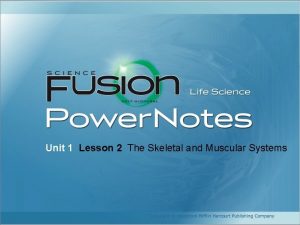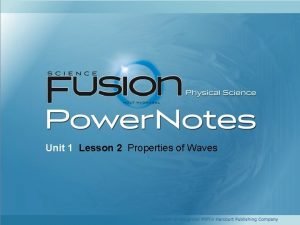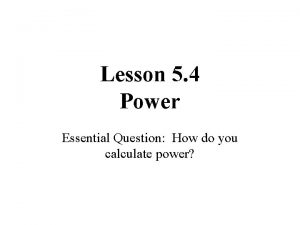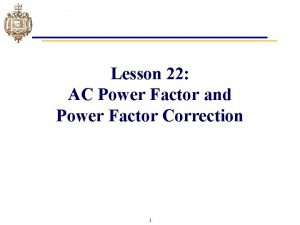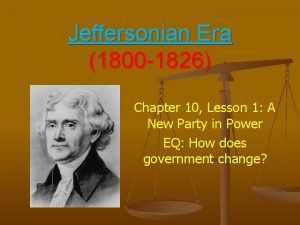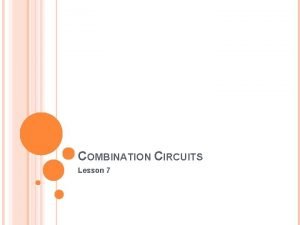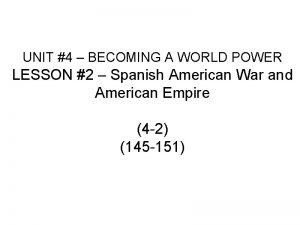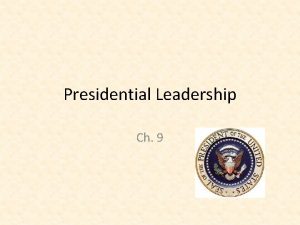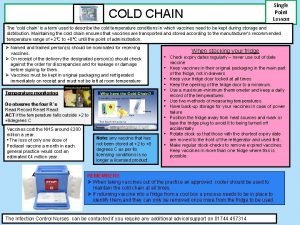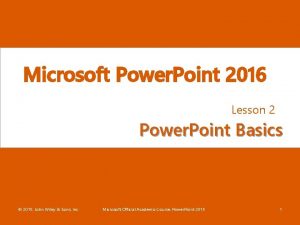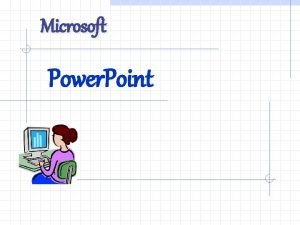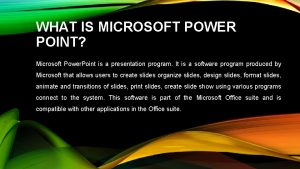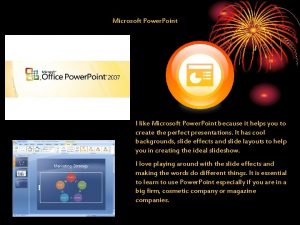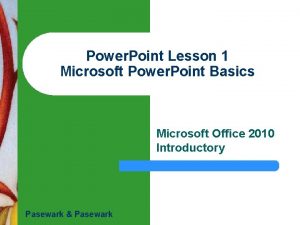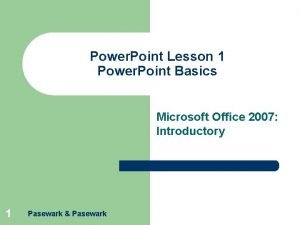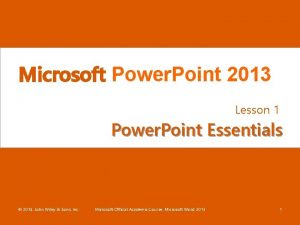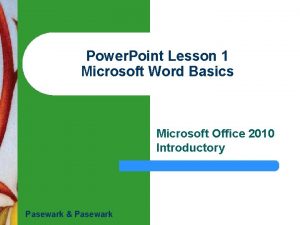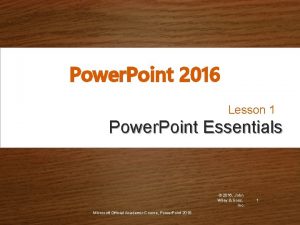Microsoft Power Point 2016 Lesson 2 Power Point





























































- Slides: 61

Microsoft Power. Point 2016 Lesson 2 Power. Point Basics © 2016, John Wiley & Sons, Inc. Microsoft Official Academic Course, Power. Point 2016 1

Objectives © 2016, John Wiley & Sons, Inc. Microsoft Official Academic Course, Power. Point 2016 2

Software Orientation • Power. Point’s New tab in Backstage view enables you to create a new presentation from a template. • You can choose templates from Office. com or browse templates stored on your own hard drive (see the next slide). © 2016, John Wiley & Sons, Inc. Microsoft Official Academic Course, Power. Point 2016 3

Software Orientation © 2016, John Wiley & Sons, Inc. Microsoft Official Academic Course, Power. Point 2016 4

Creating a New Blank Presentation • When you start Power. Point, its Start screen appears. • If you click Blank Presentation at that point, or press the Esc key, a new, blank presentation appears, containing a single slide. • The fastest and simplest way to create a new presentation is to start with a blank presentation. • You can add text to the presentation and then format the slides later. © 2016, John Wiley & Sons, Inc. Microsoft Official Academic Course, Power. Point 2016 5

Step by Step: Create a Blank Presentation at Startup • Before you begin these steps, make sure that your computer is on. Sign in to Windows, if necessary. 1. Launch Power. Point’s Start screen appears (see figure here). 2. Click Blank Presentation or press Esc. A new blank presentation appears. • CLOSE the blank presentation without saving it. LEAVE Power. Point open. © 2016, John Wiley & Sons, Inc. Microsoft Official Academic Course, Power. Point 2016 6

Step by Step: Create a Blank Presentation (Power. Point Already Open) • If Power. Point is not already open from the previous exercise, LAUNCH Power. Point. 1. 2. 3. Click the File tab. Backstage view opens. Click New. The New tab of Backstage view opens (see Figure 2 -1). Click Blank Presentation. A new, blank presentation appears in Normal view. • LEAVE the blank presentation open to use in the next exercise. • There are two advantages to using a blank presentation to start a slide show: • Power. Point creates a blank presentation every time the program starts, so you always have immediate access to the first slide of a new presentation by just pressing Esc at startup. • Because the presentation is not formatted (meaning there are no backgrounds, colors, or pictures), you can focus on writing your text. © 2016, John Wiley & Sons, Inc. Microsoft Official Academic Course, Power. Point 2016 7

Adding Text to a Blank Slide • If a blank slide has one or more text placeholders, you can easily add text to the slide. • To enter text, click the sample text in the placeholder and then type your text. • The slide you work with in the following exercise has a title placeholder and a content placeholder that can hold text and other types of content. © 2016, John Wiley & Sons, Inc. Microsoft Official Academic Course, Power. Point 2016 8

Step by Step: Add Text to a Blank Slide • USE the slide that is still on the screen. 1. Click the title placeholder at the top of the slide. The text Click to add title disappears and a blinking insertion point appears in the placeholder. 2. Type Discussion Points. 3. Click the text at the top of the lower placeholder. The words Click to add subtitle disappear and the insertion point appears. 4. Type Customer surveys and then press Enter to move the insertion point down to a new line. 5. Type Inventory tracking and press Enter. 6. Type Absenteeism policy and press Enter. © 2016, John Wiley & Sons, Inc. Microsoft Official Academic Course, Power. Point 2016 9

Step by Step: Add Text to a Blank Slide 7. Type Break and press Enter. 8. Type Store security and press Enter. 9. Type Store closing procedures and press Enter. 10. Type Cash drawer management, then click anywhere in the blank area outside the placeholder to clear its borders from the screen. 11. Click the Home tab to make it active, if necessary, and then click Layout. A drop-down menu (called a gallery) appears, displaying Power. Point’s default layouts. © 2016, John Wiley & Sons, Inc. Microsoft Official Academic Course, Power. Point 2016 10

Step by Step: Add Text to a Blank Slide 12. Click the Title and Content thumbnail in the gallery. The gallery closes and Power. Point applies the Title and Content layout to the current slide (see Figure 2 -3) so the subtitle format is replaced with bullets. • LEAVE the presentation open to use in the next exercise. © 2016, John Wiley & Sons, Inc. Microsoft Official Academic Course, Power. Point 2016 11

Saving a Presentation • When you create a new presentation, it exists only in your computer’s memory. • If you want to keep the presentation, you must save it on your computer, the Web, a network location, or a flash drive. • After you save a file, you can close it and then open it later to resume working on it. • When you save a presentation for the first time, Power. Point displays the Save As dialog box so you name the presentation before saving it. © 2016, John Wiley & Sons, Inc. Microsoft Official Academic Course, Power. Point 2016 12

Step by Step: Save a New Presentation • USE the presentation that is still on the screen from the preceding exercise. 1. On the Quick Access Toolbar, click Save. The Save As tab of Backstage view appears. 2. Navigate to the folder where you want to save your file. To do so, click either One. Drive, Other Web Locations, or This PC, and then click Browse. Then use the Save As dialog box to find the location as needed. 3. Select the text in the File name box by dragging the mouse pointer over it and then press Delete to delete it. 4. Type Managers Meeting. 5. Click Save. Power. Point saves the presentation in the folder you chose with the name you gave it. • LEAVE the presentation open to use in the next exercise. © 2016, John Wiley & Sons, Inc. Microsoft Official Academic Course, Power. Point 2016 13

Embedding Fonts • When you create a presentation, you can choose any of the fonts installed on that computer. • If you present a presentation on a computer that does not have the same font installed, Power. Point substitutes a different font, which may or may not display correctly. • To ensure that the correct font is always available no matter which computer you open the presentation on, you can embed the fonts in the presentation file. • Embedding fonts makes the presentation file size larger. © 2016, John Wiley & Sons, Inc. Microsoft Official Academic Course, Power. Point 2016 14

Step by Step: Embed Fonts When Saving • USE the presentation that is open from the previous exercise. 1. Click the File tab and then click Save As. 2. Browse to the location where you want to save. 3. In the Save As dialog box, click Tools. A menu opens. 4. Click Save Options. The Power. Point Options dialog box opens. © 2016, John Wiley & Sons, Inc. Microsoft Official Academic Course, Power. Point 2016 15

5. Step by Step: Embed Fonts Mark the Embed fonts When Saving in the file check box. This check box is located under the Preserve fidelity when sharing this presentation heading (see figure). 6. Click OK. 7. SAVE the presentation file and then CLOSE it. • LEAVE Power. Point open to use in the next exercise. © 2016, John Wiley & Sons, Inc. Microsoft Official Academic Course, Power. Point 2016 16

Step by Step: Embed Fonts When Saving • When you mark the Embed fonts in the file check box in step 5, two option buttons become available. Click the one that best fits your needs: • Embed only the characters used in the presentation (best for reducing file size): Choose this option if the presentation text is final, if you do not anticipate making any changes to it. • Embed all characters (best for editing by other people): Choose this option if the presentation text is not final, or if file size is not important. © 2016, John Wiley & Sons, Inc. Microsoft Official Academic Course, Power. Point 2016 17

Creating a Presentation from a Template • A template is a reusable sample file that includes a background, layouts, coordinating fonts, and other design elements that work together to create an attractive, finished slide show. Templates may contain sample content, too. • Each template employs one or more themes. • A theme is a collection of settings including colors, fonts, background graphics, bullet graphics, and margin and placement settings. • You can create your own templates or download new ones from Office. com. © 2016, John Wiley & Sons, Inc. Microsoft Official Academic Course, Power. Point 2016 18

Step by Step: Create a Presentation from a Template • If Power. Point is not already open from the previous exercise, LAUNCH Power. Point. 1. Click the File tab. 2. Click New to open the New tab. 3. In the Search box, type photo albums and then press Enter or click the Search button. Thumbnail images of the photo album templates appear. 4. Scroll down to locate and click the Classic photo album thumbnail (see the figure on the next slide), then click Create in the Preview pane, which appears in the middle of the screen. Power. Point opens a new presentation based on the selected template. It contains several sample slides with text and graphics. © 2016, John Wiley & Sons, Inc. Microsoft Official Academic Course, Power. Point 2016 19

Step by Step: Create a Presentation from a Template 5. On slide 1, select Classic Photo Album and type Northwind Traders to replace it. © 2016, John Wiley & Sons, Inc. Microsoft Official Academic Course, Power. Point 2016 20

Step by Step: Create a Presentation from a Template 6. Click the text in the date and other details placeholder to place the insertion point there. Type New Product Preview, press Enter, and then type January 2016 (see below). © 2016, John Wiley & Sons, Inc. Microsoft Official Academic Course, Power. Point 2016 21

Step by Step: Create a Presentation from a Template 7. On the Quick Access Toolbar, click Save. The Save As tab of Backstage view appears. 8. Navigate to the folder where you want to save your files and then save the presentation with the file name New Product Preview. • LEAVE the presentation open to use in the next exercise. • It is important to choose a template that is appropriate for your audience and your message. • For business, choose a template that looks professional and does not have elements that will distract the audience from getting your message. • Young people may like a whimsical template better. • You can also store and use your own templates. Click the Custom (or Personal) heading beneath the Suggested searches line on the New tab of Backstage view and then browse to locate the template you want to use from your own template collection. © 2016, John Wiley & Sons, Inc. Microsoft Official Academic Course, Power. Point 2016 22

Adding, Deleting, and Organizing Slides • In Power. Point, it is easy to add, delete, and reorder the slides in a presentation to suit your unique needs. • You can add as many new slides as you want to a presentation using the New Slide command on the Ribbon, or using the Slides pane. © 2016, John Wiley & Sons, Inc. Microsoft Official Academic Course, Power. Point 2016 23

Step by Step: Add a New Slide • USE the New Product Preview presentation that is still open from the previous exercise. 1. On the Home tab in the Slides group, click the New Slide button drop-down arrow. A gallery opens, showing thumbnail images of the slide layouts that are available for this template. 2. Scroll down to the bottom of the gallery and then click Title and Content. 3. On the new slide, click the title placeholder and type This Year’s New Products. © 2016, John Wiley & Sons, Inc. Microsoft Official Academic Course, Power. Point 2016 24

Step by Step: Add a New Slide 4. Click the sample text at the top of the second placeholder and then type the following items, placing each item on its own line: • • • 5. Women’s jackets Men’s jackets Boots Backpacks Flannel shirts Fleece Turtlenecks Underwear Socks Click in the area surrounding the slide to clear the placeholder’s border. When you are done, your slide should look like the one shown in above. © 2016, John Wiley & Sons, Inc. Microsoft Official Academic Course, Power. Point 2016 25

Step by Step: Add a New Slide 6. On the View tab, click the Outline View button to switch to Outline view. 7. In the Outline pane, click to place the text insertion point after the word Socks in slide 2 and then press Enter, creating a new paragraph. At this point the new paragraph is a bullet on slide 2. 8. Press Shift+Tab. The new paragraph is promoted into a new slide title. 9. Type Clearance Items and then press Enter. A new slide appears. Because the previous paragraph was a slide title, the new one is too. 10. Press Tab. The new paragraph is indented so that it is a bullet on the Clearance Items slide. 11. Type the following items, pressing Enter after each one except the last item to place it in its own paragraph: Biking accessories, Camping supplies, and Spelunking gear. 12. After all the text is typed in for the new slide, it appears in the Outline. • LEAVE the presentation open to use in the next exercise. © 2016, John Wiley & Sons, Inc. Microsoft Official Academic Course, Power. Point 2016 26

Duplicating Selected Slides • If you want several similar slides in a presentation, you can save time by duplicating some of the slides and then modifying the copies. • The following exercise shows how to select the slides you want to duplicate, even when they are non-contiguous (not adjacent), and make copies of them. • You will also learn how to use the Duplicate Microsoft Official Academic Course, Power. Point 2016 duplicates Selected Slides command to make of slides. © 2016, John Wiley & Sons, Inc. 27

Step by Step: Duplicate Non. Contiguous Slides • USE the New Product Preview presentation that is still open from the previous exercise. 1. Click the Slide Sorter button on the View tab to change to Slide Sorter view. The presentation’s slides appear together in a single pane. 2. Click slide 4. An orange outline appears around it, indicating that it is selected. 3. Hold down Ctrl and click slide 7. An orange outline appears around it too (see the figure on the next slide). 4. Click the Home tab and then click Copy. The two slides are copied to the Clipboard. 5. Click to the right of slide 9. A vertical line appears there. © 2016, John Wiley & Sons, Inc. Microsoft Official Academic Course, Power. Point 2016 28

Step by Step: Duplicate Non. Contiguous Slides © 2016, John Wiley & Sons, Inc. Microsoft Official Academic Course, Power. Point 2016 29

Step by Step: Duplicate Non. Contiguous Slides 6. On the Home tab, click Paste. The copied slides are pasted after slide 9. 7. Click slide 2 (This Year’s New Products) to select it. 8. On the Home tab, open the New Slide button’s drop-down list. 9. Click Duplicate Selected Slides. A copy of slide 2 is pasted directly following the original slide 2. 10. SAVE the presentation file and then CLOSE it. • LEAVE Power. Point open for the next exercise. © 2016, John Wiley & Sons, Inc. Microsoft Official Academic Course, Power. Point 2016 30

Rearranging the Slides in a Presentation • Reorganizing slides is a simple drag-and-drop procedure. • In Slide Sorter view (or in the Outline pane in Normal view), you click a slide and drag it to a new location in the presentation. • A line shows you where the slide will be placed when you drop it. • Moving a slide is a simple procedure, as you will learn in the following exercise. © 2016, John Wiley & Sons, Inc. Microsoft Official Academic Course, Power. Point 2016 31

Step by Step: Rearrange the Slides in a Presentation • OPEN the Management Values presentation from the data files for this lesson. 1. SAVE the file as Management Values Final. 2. Click the View tab and then click the Slide Sorter button to change to Slide Sorter view. The presentation’s slides appear together in a single window. 3. Use the Zoom control in the status bar to set the Zoom so all the slides fit on one screen. 4. Click slide 5 (Our extended family) and drag it to the left of slide 4 (Our customers). The moved slide is now slide 4 (see the figure on the next slide). © 2016, John Wiley & Sons, Inc. Microsoft Official Academic Course, Power. Point 2016 32

Step by Step: Rearrange the Slides in a Presentation © 2016, John Wiley & Sons, Inc. Microsoft Official Academic Course, Power. Point 2016 33

Step by Step: Rearrange the Slides in a Presentation 5. Switch to Outline view, and in the Outline pane, click the icon to the left of slide 7’s title (We commit ourselves). All the text from slide 7 is selected. 6. Drag slide 7’s icon downward. When a vertical line appears between slides 8 and 9, release the mouse button. The moved slide is now slide 8. 7. Switch to Normal view and select slide 8 Microsoft Official Academic Course, Power. Point 2016 (We commit ourselves). © 2016, John Wiley & Sons, Inc. 34

8. Step by Step: Rearrange the Drag slide 8 downward Slides in a Presentation and drop it between slides 9 and 10 (see figure) and then release the mouse button. The moved slide is now slide 9. SAVE the presentation. • LEAVE the presentation open to use in the next exercise. © 2016, John Wiley & Sons, Inc. Microsoft Official Academic Course, Power. Point 2016 35

Step by Step: Delete a Slide • USE the Management Values Final presentation that is still open from the previous exercise. 10. In Slide Sorter view, click slide 10 (the blank slide). 11. Press the Delete key. The slide is removed from the presentation. 12. SAVE the presentation and then CLOSE the presentation file. • LEAVE Power. Point open for the next exercise. • To delete more than one slide at a time for deletion, hold down the Ctrl key and select each slide you want to delete. • Power. Point does not ask whether you are sure if you want to delete a slide, so it is important to be careful before deleting. • If you accidentally delete a slide, click the Undo button on the Quick Access Toolbar right away to bring the slide back (see figure). © 2016, John Wiley & Sons, Inc. Microsoft Official Academic Course, Power. Point 2016 36

Creating a Presentation from Existing Content • Power. Point imports content easily from a variety of formats, including Word outlines, other Power. Point presentations, and slide libraries. • Microsoft Word’s Outline view enables you to create a well-structured hierarchical outline that consists of multiple heading levels. • You can then open such outlines in Power. Point, where each of the major headings becomes a slide title and each of the minor headings becomes a bullet of body text. © 2016, John Wiley & Sons, Inc. Microsoft Official Academic Course, Power. Point 2016 37

Step by Step: Start a Presentation from a Word Outline • If Power. Point is not already open from the previous exercise, LAUNCH Power. Point. 1. In Power. Point, click the File tab. 2. Click Open to display the Open tab of Backstage view. 3. Navigate to the folder that contains the data files for this lesson. 4. OPEN the File type drop-down list by clicking the All Power. Point Presentations button. © 2016, John Wiley & Sons, Inc. Microsoft Official Academic Course, Power. Point 2016 38

Step by Step: Start a Presentation from a Word Outline 5. In the File type list, click All Outlines. The file listing in the dialog box changes to show outlines (including Word documents). The file location is the same; the only thing that’s changed is the filter that determines which file types are displayed (see right). 6. Click Computer Use Policy. docx. 7. Click the Open button. The outline opens as a new presentation. © 2016, John Wiley & Sons, Inc. Microsoft Official Academic Course, Power. Point 2016 39

Step by Step: Start a Presentation from a Word Outline 8. SAVE the new presentation as Computer Use Policy Final. pptx and then CLOSE the file. • LEAVE Power. Point open to use in the next exercise. • Before you can create slides from a Word outline, the outline must be formatted correctly. • Paragraphs formatted with Word’s Heading 1 style become slide titles. • Paragraphs formatted with subheading styles (such as Heading 2 or Heading 3) are converted into bulleted lists in the slides’ subtitle placeholders. • Any Word document can be opened in Power. Point and converted to a presentation, but documents that are not structured as outlines may require quite a bit of cleanup in Power. Point after importing. © 2016, John Wiley & Sons, Inc. Microsoft Official Academic Course, Power. Point 2016 40

Reusing Slides from Presentations and Libraries • It is easy to reuse a slide from one presentation in another. • This technique frees you from creating the same slide from scratch more than once. • Some companies store frequently used slides in slide libraries on their file servers, so multiple users can draw from a common pool of premade slides. © 2016, John Wiley & Sons, Inc. Microsoft Official Academic Course, Power. Point 2016 41

Step by Step: Reuse a Slide from a Presentation • OPEN the New Product Preview presentation that you created earlier in this lesson. Change your file to Normal view if needed. 1. On the Home tab of the Ribbon, click the New Slide button drop -down arrow. At the bottom of the gallery that appears, click Reuse Slides. The Reuse Slides task pane opens on the right side of the Power. Point window (see the figure on the next slide). 2. In the task pane, click the Browse button. A drop-down list opens. Click Browse File. The Browse dialog box opens. 3. Locate and open New Jackets in the Student Data Files Lesson 02 folder. The presentation’s slides appear in the task pane. 4. In the Slides pane, click slide 2 (This Year’s New Products) to select it. © 2016, John Wiley & Sons, Inc. Microsoft Official Academic Course, Power. Point 2016 42

Step by Step: Reuse a Slide from a Presentation © 2016, John Wiley & Sons, Inc. Microsoft Official Academic Course, Power. Point 2016 43

Step by Step: Reuse a Slide from a Presentation 5. In the Reuse Slides task pane, click slide 2 (This Year’s New Jackets) in the New Jackets presentation. The slide is inserted into the New Product Preview presentation as the new slide 3. 6. Click the Close button in the upper-right corner of the task pane. 7. SAVE and CLOSE the New Product Preview presentation. • LEAVE Power. Point open to use in the next exercise. © 2016, John Wiley & Sons, Inc. Microsoft Official Academic Course, Power. Point 2016 44

Step by Step: Reuse a Slide from a Presentation • The steps for selecting a slide from a slide library are very similar to those for selecting from a presentation. • Follow the preceding steps, but in step 2, instead of choosing Browse File, choose Browse Slide Library. • The first time you access the slide library, you must type the URL in the Folder Name box; after that, the location defaults to that same © 2016, John Wiley & Sons, Inc. Microsoft Official Academic Course, Power. Point 2016 library. 45

Importing Text from Other Sources • One way to import text is to use the Clipboard, because nearly all Windows applications support Clipboard use. • You can use the Paste Options icon after pasting text to choose how it will be pasted, or use Paste Special to select special pasting methods. • In the following exercise, you learn how to paste text from a plain text file and from a Word document into Power. Point, and you practice using the Paste Special command to maintain the content’s original text formatting from the Word document. • These same techniques also work on graphics. © 2016, John Wiley & Sons, Inc. Microsoft Official Academic Course, Power. Point 2016 46

Step by Step: Import Text into Power. Point • If Power. Point is not already open from the previous exercise, LAUNCH Power. Point. 1. START Microsoft Word and then OPEN Other Resources. docx. The procedure for opening files in Word is the same as in Power. Point. 2. In Microsoft Power. Point, OPEN Cashier Training. SAVE it as Cashier Training 1. 3. Switch to Outline view and scroll down to the bottom of the presentation in the Outline pane. Click after the last bullet point on the last slide and press Enter, creating a new bulleted paragraph. 4. Press Shift+Tab to promote the new paragraph to a new slide (see figure). © 2016, John Wiley & Sons, Inc. Microsoft Official Academic Course, Power. Point 2016 47

Step by Step: Import Text into Power. Point 5. Go to the open Other Resources file in Word. Select the heading (Other Resources) and press Ctrl+C to copy it to the Clipboard. 6. In Power. Point, if the insertion point is not already on the Outline pane next to the slide 9 icon, click to place it there. 7. Press Ctrl+V to paste the text. The text appears as the slide’s title, and a Paste Options icon appears beside the text. If you do not see the icon, move the mouse pointer over slide 9’s icon to the left of the pasted text. 8. Click the Paste Options icon to open its menu. Its menu contains the Paste Options icons (see figure). © 2016, John Wiley & Sons, Inc. Microsoft Official Academic Course, Power. Point 2016 48

Step by Step: Import Text into Power. Point 9. Click Keep Source Formatting (the second icon from the left). The pasted text’s font changes to the original font it had in the Word document. 10. In the Other Resources file in Word, select the bulleted list. Press Ctrl+C to copy it to the Clipboard. 11. In Power. Point, click the Click to add text placeholder on the left side of the slide (in the Slide pane) to move the insertion point into that text box. 12. On the Home tab of the Ribbon, click the Paste button drop-down arrow. A menu opens, containing the same types of icons as found on the Paste Options icon’s menu (step 8), and also containing a Paste Special command. 13. Click Paste Special. The Paste Special dialog box opens. 14. Verify that the Paste option button is selected. 15. On the As list, click Formatted Text (RTF). © 2016, John Wiley & Sons, Inc. Microsoft Official Academic Course, Power. Point 2016 49

Step by Step: Import Text into Power. Point 16. Click OK. The text is pasted into the slide keeping the text’s original formatting. The text overflows the placeholder’s borders. That is normal at this point. 17. Triple-click the last bullet on the slide (Special training) to select the entire bullet, and press Ctrl+X to cut the bullet to the Clipboard. 18. Click in the Click to add text placeholder on the right side of the slide, and press Ctrl+V to paste the bullet into that placeholder. The finished slide should resemble the figure shown here. © 2016, John Wiley & Sons, Inc. Microsoft Official Academic Course, Power. Point 2016 50

Step by Step: Import Text into Power. Point 19. In the Slides pane in Normal view, click between slides 8 and 9. A horizontal line appears between them. 20. On the Home tab, click the down arrow below the New Slide button, opening a menu, and then click Slides from Outline. 21. In the Insert Outline dialog box, navigate to the data files for this lesson, select Contacts. txt and then click Insert. A new slide appears containing the content from Contacts. txt. 22. SAVE the Cashier Training 1 presentation. 23. CLOSE Word without saving the changes to Other Resources. docx. • LEAVE the presentation open to use in the next exercise. © 2016, John Wiley & Sons, Inc. Microsoft Official Academic Course, Power. Point 2016 51

Printing a Presentation • In the following exercises, you learn how to preview a presentation before printing it, how to choose a printer, how to set print options, and how to print a presentation in both color, grayscale, and black and white mode. • Power. Point’s Print Preview feature shows you how your slides will look on paper before you print them. • When you change to a different print layout, Print Preview reflects the change, so you can try different potential layouts for your presentation printouts before committing one to paper. © 2016, John Wiley & Sons, Inc. Microsoft Official Academic Course, Power. Point 2016 52

Step by Step: Use Print Preview and Change the Print Layout • USE the Cashier Training 1 presentation that is still open from the previous exercise. 1. On the View tab, click the Normal view button and display slide 1 (Cashier Training). 2. Click the File tab and then click Print. A preview of the print job appears in the right pane. The default print layout is Full Page Slides (see figure). © 2016, John Wiley & Sons, Inc. Microsoft Official Academic Course, Power. Point 2016 53

Step by Step: Use Print Preview and Change the Print Layout 3. Click the Next Page arrow at the bottom of the window. A preview of slide 2 appears. 4. In the left pane, under the Settings heading, click Full Page Slides to open a menu of layouts. 5. Click 6 Slides Vertical under the Handouts section on the menu of layouts. Print Preview changes to show a page containing six small slides. 6. Click the 6 Slides Vertical button and click Outline. Print Preview shows the presentation as a text-only outline. © 2016, John Wiley & Sons, Inc. Microsoft Official Academic Course, Power. Point 2016 54

Step by Step: Use Print Preview and Change the Print Layout 7. Click Outline and then click Notes Pages. Print Preview shows slide 2 with the existing notes in the notes area below the slide (see below). © 2016, John Wiley & Sons, Inc. Microsoft Official Academic Course, Power. Point 2016 55

Step by Step: Use Print Preview and Change the Print Layout 8. Click the Back button (the left pointing arrow in the far upper left corner in the Categories pane) or press Esc to leave Backstage view without printing anything. 9. SAVE your changes. • LEAVE the presentation open to use in the next exercise. © 2016, John Wiley & Sons, Inc. Microsoft Official Academic Course, Power. Point 2016 56

Setting Print Options • In addition to choosing a layout, Power. Point lets you set a number of other attributes before printing a presentation. • The following exercise shows you how to set some of these printing options. • One of these options is grayscale mode, in which there are no colors; each color appears as a shade of gray. • Grayscale mode is often used for draft copies because it minimizes the use of expensive colored ink or toner. • Another option is to print in black and white. • You can also choose to print only certain slides, and to print multiple copies. © 2016, John Wiley & Sons, Inc. Microsoft Official Academic Course, Power. Point 2016 57

• Step by Step: Set Print USE the Cashier Training 1 presentation Options that is still open from the previous exercise. 1. Click the File tab and then click Print. The printing options and Print Preview appear in Backstage view. The Notes Pages layout is still selected from the previous exercise. 2. In the Copies box at the top of the window, type 2 to print two copies. 3. Under the Printer heading, click the down arrow. A menu appears of other available printers (if any) (see right). © 2016, John Wiley & Sons, Inc. Microsoft Official Academic Course, Power. Point 2016 58

Step by Step: Set Print Options 4. Click away from the open menu to close it without making a change. 5. In the Slides: text box (under Print All Slides), type 1 -3. Specifying 1 -3 sets only the first three slides to be printed, and Print All Slides changes to Custom Range. 6. Click the Custom Range drop-down arrow and note the command at the bottom of its menu: Print Hidden Slides. That option is not currently available because there are no hidden slides in this presentation. 7. Click away from the menu to close it without making a change. © 2016, John Wiley & Sons, Inc. Microsoft Official Academic Course, Power. Point 2016 59

Step by Step: Set Print Options 8. Click the Collated drop-down arrow to open a menu of collation options. When you are printing multiple copies, you can choose to have the copies collated or not. 9. Click away from the Collated button’s menu to close it without making a change. 10. Click the Color drop-down arrow to open a menu of color options. 11. Click Pure Black and White from the Color button’s menu. Print Preview changes to show the setting will affect the printouts. 12. If you want to print now, click the Print button. Be sure to follow your instructor’s instructions before printing. Otherwise, click the Back button or press Esc to leave Backstage view without printing. 13. SAVE the file as Cashier Training Final. • EXIT Power. Point. © 2016, John Wiley & Sons, Inc. Microsoft Official Academic Course, Power. Point 2016 60

Skill Summary © 2016, John Wiley & Sons, Inc. Microsoft Official Academic Course, Power. Point 2016 61
 Microsoft official academic course microsoft word 2016
Microsoft official academic course microsoft word 2016 Microsoft official academic course microsoft excel 2016
Microsoft official academic course microsoft excel 2016 Microsoft official academic course microsoft word 2016
Microsoft official academic course microsoft word 2016 Exploring microsoft office 2016
Exploring microsoft office 2016 Exploring microsoft office excel 2016 comprehensive
Exploring microsoft office excel 2016 comprehensive Excel lesson 4 vocabulary
Excel lesson 4 vocabulary Microsoft office 2016 in practice
Microsoft office 2016 in practice Threat modeling tools microsoft
Threat modeling tools microsoft Microsoft excel 2016 basics vocabulary
Microsoft excel 2016 basics vocabulary Pengoperasian power point
Pengoperasian power point Power point microsoft
Power point microsoft Que es microsoft power point
Que es microsoft power point Microsoft power point 2010
Microsoft power point 2010 Draw the power triangle
Draw the power triangle Power bi training powerpoint
Power bi training powerpoint Microsoft microsoft edge startwarren theverge
Microsoft microsoft edge startwarren theverge Spreadsheet adalah program microsoft
Spreadsheet adalah program microsoft Point point power
Point point power Powerpoint lesson 1
Powerpoint lesson 1 Microsoft power bi stack
Microsoft power bi stack Analyzing and visualizing data with microsoft power bi
Analyzing and visualizing data with microsoft power bi Power bi embedded demo
Power bi embedded demo Microsoft word power
Microsoft word power Microsoft power automate grundkurs
Microsoft power automate grundkurs Lesson outline lesson 3 describing circuits answers
Lesson outline lesson 3 describing circuits answers Lesson outline lesson 3 mountain building answers
Lesson outline lesson 3 mountain building answers Lesson outline lesson 2 aquatic ecosystems answer key
Lesson outline lesson 2 aquatic ecosystems answer key Define micro lesson
Define micro lesson L 101: introduction to health care leadership
L 101: introduction to health care leadership Learning outcomes of a gift of chappals
Learning outcomes of a gift of chappals Chapter 1 lesson 1 your total health answer key
Chapter 1 lesson 1 your total health answer key Lesson outline lesson 3 weather forecasts answer key
Lesson outline lesson 3 weather forecasts answer key Sat vocabulary lesson and practice lesson 4
Sat vocabulary lesson and practice lesson 4 Lesson outline lesson 2 - physical properties answer key
Lesson outline lesson 2 - physical properties answer key Lesson outline lesson 1 solids liquids and gases answer key
Lesson outline lesson 1 solids liquids and gases answer key Lesson outline climates of earth
Lesson outline climates of earth Lesson outline lesson 1
Lesson outline lesson 1 Lesson 2 measurement and scientific tools
Lesson 2 measurement and scientific tools Today lesson or today's lesson
Today lesson or today's lesson Lesson 1 land biomes answer key
Lesson 1 land biomes answer key Lesson 4 gravity and motion lesson review
Lesson 4 gravity and motion lesson review Lesson 2 muscle storyboard
Lesson 2 muscle storyboard Lesson outline lesson 2 wave properties answer key
Lesson outline lesson 2 wave properties answer key Today's lesson or today lesson
Today's lesson or today lesson 1 important lesson that is worth sharing about this lesson
1 important lesson that is worth sharing about this lesson Example of repitition
Example of repitition Lesson outline lesson 1 magnets and magnetic fields
Lesson outline lesson 1 magnets and magnetic fields Lesson outline lesson 3 eclipses and tides answer key
Lesson outline lesson 3 eclipses and tides answer key A 50 kg student climbs 5m up a rope
A 50 kg student climbs 5m up a rope Lesson 1: power factor
Lesson 1: power factor Chapter 10 lesson 2 the louisiana purchase
Chapter 10 lesson 2 the louisiana purchase Chapter 10 lesson 1 a new party in power
Chapter 10 lesson 1 a new party in power The jefferson era lesson 1 a new party in power
The jefferson era lesson 1 a new party in power Lesson 4: how to calculate power in dc combination circuits
Lesson 4: how to calculate power in dc combination circuits Becoming a world power lesson 2 the spanish american war
Becoming a world power lesson 2 the spanish american war Becoming a world power lesson 2 the spanish american war
Becoming a world power lesson 2 the spanish american war Chapter 5 lesson 3 new american diplomacy
Chapter 5 lesson 3 new american diplomacy Lesson 3 enlightened absolutism and the balance of power
Lesson 3 enlightened absolutism and the balance of power Informal powers
Informal powers Lesson 2 power factor correction
Lesson 2 power factor correction Single point lesson
Single point lesson Lab tervetuloa opiskelemaan
Lab tervetuloa opiskelemaan



